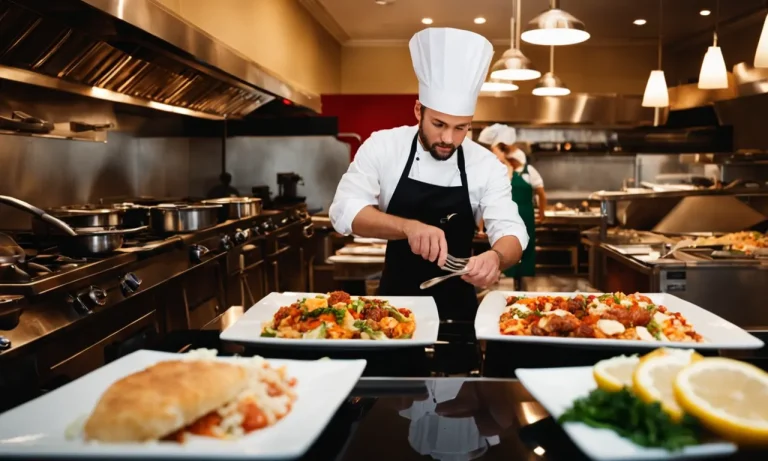Korean cuisine is delicious, diverse, and full of flavor. Walking into a Korean restaurant can be overwhelming if you don’t know what to order. Have no fear – this guide will cover the best traditional and popular Korean dishes, giving you a taste of what you should look for on the menu.
If you’re short on time, here’s a quick answer to what to order at a Korean restaurant: bibimbap, bulgogi, galbi, kimchi jjigae, budae jjigae, naengmyeon, and hotteok are some of the most iconic Korean dishes you don’t want to miss.
Traditional Main Course Dishes
Bibimbap
Bibimbap is a popular Korean dish that literally translates to “mixed rice.” It is a bowl of steamed rice topped with an assortment of vegetables, meat (usually beef), and a fried egg. The ingredients are then mixed together with a spicy gochujang sauce to create a flavorful and satisfying meal.
Bibimbap is known for its vibrant colors and diverse flavors, making it a favorite among locals and tourists alike. It is often served in a hot stone bowl, which adds a crispy texture to the rice.
Bulgogi
Bulgogi is a classic Korean dish made with thinly sliced marinated beef. The meat is typically marinated in a mixture of soy sauce, sugar, sesame oil, garlic, and other seasonings to enhance its flavor. Once marinated, the beef is grilled or pan-fried until it is tender and juicy.
Bulgogi is known for its sweet and savory taste, and it is often served with a side of rice and various banchan (side dishes). The tender and flavorful meat makes it a popular choice for both locals and visitors to Korean restaurants.
Galbi
Galbi, also known as Korean-style short ribs, is a beloved dish in Korean cuisine. The ribs are marinated in a sauce made with soy sauce, garlic, ginger, sugar, and other ingredients to give them a rich and savory flavor.
The marinated ribs are then grilled or broiled until they are tender and caramelized. Galbi is often served with a side of rice and lettuce leaves, which are used to wrap the meat for added freshness and crunch.
This dish is a favorite among meat lovers and is perfect for those who enjoy a flavorful and satisfying meal.
Noodle and Soup Dishes
Kimchi Jjigae
Kimchi Jjigae is a popular Korean soup dish made with kimchi, a traditional fermented vegetable dish. It is a spicy and flavorful soup that is often enjoyed during the cold winter months. The main ingredients of Kimchi Jjigae include kimchi, pork, tofu, and various vegetables such as onions, green onions, and mushrooms.
The soup is typically simmered for a long time to allow the flavors of the ingredients to meld together. The result is a comforting and hearty dish that is perfect for warming up on a chilly day.
Budae Jjigae
Budae Jjigae, also known as Army Stew, is a unique Korean dish that originated during the Korean War. It was created using surplus food from U.S. military bases, hence the name “Army Stew.” This dish is a fusion of Korean and American flavors, combining ingredients like spam, hot dogs, kimchi, tofu, instant noodles, and various vegetables.
Budae Jjigae is known for its spicy and savory taste and is often enjoyed with a group of friends or family. It is a fun and interactive dish as the ingredients are cooked together at the table, allowing everyone to customize their own bowl.
Naengmyeon
Naengmyeon is a popular Korean noodle dish that is typically served cold, making it a refreshing option during the hot summer months. The noodles used in Naengmyeon are made from buckwheat or sweet potato starch, giving them a chewy texture.
There are two main types of Naengmyeon: Mul Naengmyeon, which is served in a tangy cold beef broth, and Bibim Naengmyeon, which is mixed with a spicy sauce. The dish is garnished with various toppings such as cucumber, radish, sesame seeds, and a boiled egg.
Naengmyeon is a light and refreshing dish that is perfect for beating the summer heat.
Popular Side Dishes
Banchan
Banchan, also known as side dishes, are an essential part of any Korean meal. These small dishes are served alongside the main course and are meant to be shared among diners. Banchan can range from simple pickled vegetables to more elaborate preparations.
They not only add variety to the meal but also provide a balance of flavors and textures. Some popular banchan include:
- Kongnamul: This is a refreshing bean sprout salad tossed in a light soy sauce dressing. It provides a crisp and crunchy texture that complements the main dish.
- Kimchi: Kimchi is a staple Korean side dish made from fermented vegetables, most commonly cabbage. It is spicy, tangy, and packed with umami flavors.
- Radish Kimchi: Similar to regular kimchi, radish kimchi is made from fermented radishes. It has a milder flavor compared to cabbage kimchi but is equally delicious.
- Japchae: Japchae is a stir-fried dish made with glass noodles, vegetables, and meat. It is seasoned with soy sauce and sesame oil, giving it a savory and slightly sweet taste.
These are just a few examples of the wide variety of banchan you can expect to find at a Korean restaurant. Each dish offers a unique flavor profile, adding depth and complexity to the dining experience.
Kimchi
Kimchi is arguably the most well-known Korean side dish. It has gained popularity worldwide for its distinct flavor and health benefits. Made from fermented vegetables, typically cabbage or radishes, kimchi is rich in probiotics and vitamins.
Its spicy and tangy taste adds a punch of flavor to any meal.
There are many different types of kimchi, each with its own unique twist. Some popular variations include:
- Baechu Kimchi: Baechu kimchi, also known as cabbage kimchi, is the most common type of kimchi. It is made by fermenting Napa cabbage with a mixture of chili pepper flakes, garlic, ginger, and other seasonings.
- Kkakdugi: Kkakdugi is a type of kimchi made from radishes. It has a crisp texture and a slightly sweet and tangy taste.
- Chonggak Kimchi: Chonggak kimchi is made from small, whole radishes. It has a crunchy texture and a refreshing, slightly spicy flavor.
Kimchi is not only delicious but also incredibly versatile. It can be enjoyed as a side dish, used as an ingredient in various dishes, or even turned into kimchi fried rice. Its popularity is evident in the fact that it has been designated as a UNESCO Intangible Cultural Heritage item.
To learn more about Korean cuisine and its various dishes, you can visit www.visitkorea.com.
Desserts
Hotteok
If you have a sweet tooth, then Hotteok is a must-try dessert at a Korean restaurant. This delicious treat is a popular street food in Korea, known for its crispy exterior and gooey, sweet filling. Made from a yeast-based dough, Hotteok is typically filled with a mixture of brown sugar, cinnamon, and chopped nuts.
The delicate balance of textures and flavors makes it a delightful dessert that is loved by locals and tourists alike.
Hotteok is often served piping hot, right off the griddle, ensuring that the filling remains warm and gooey. As you take a bite into this delectable treat, you’ll be greeted with a burst of sweetness and a satisfying crunch. It’s no wonder that Hotteok is a favorite among those with a sweet tooth!
Patbingsu
Patbingsu, also known as Korean shaved ice, is a refreshing dessert that is perfect for those hot summer days. It consists of a mound of finely shaved ice topped with a variety of colorful and delicious toppings.
The most common toppings include sweetened red beans, fruit, condensed milk, and sometimes even ice cream.
Patbingsu is a popular dessert in Korea, and you can find it at many cafes and dessert shops. It’s a great way to cool down and indulge in some sweet treats at the same time. The combination of the fluffy shaved ice and the different toppings creates a delightful symphony of flavors and textures.
Whether you’re a fan of fruity flavors or prefer the classic combination of red beans and condensed milk, there’s a Patbingsu variation for everyone. So, the next time you visit a Korean restaurant, don’t forget to end your meal on a sweet note with a bowl of Patbingsu!
Conclusion
Korean cuisine has so much variety and complex flavors to offer. Following this guide on what dishes to try will give you a wonderful introduction to the diversity of Korean food. With so many tasty options, you’ll want to come back to try even more.
Gamsahabnida (Thank you) for reading, and enjoy your Korean food adventures!






